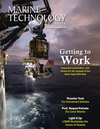
Page 51: of Marine Technology Magazine (July 2021)
Autonomous Vehicle Operations
Read this page in Pdf, Flash or Html5 edition of July 2021 Marine Technology Magazine
vessels, Sparrock manages the historic deep-submersible ve- hicle ALVIN; and the Floating Instrument Platform, or FLIP, which are charter-leased to U.S. academic research institu- tions to operate and maintain in support of Navy and U.S. ocean research objectives.
First entering service in 1964, deep diving ALVIN may seem old. But Sparrock said ALVIN has been systematically mod- ernized and upgraded over the years to remain quite youthful.
She has made more than 5,000 dives, and her depth capability has recently been upgraded her 6500-meters. “She’s been re- built so often that it’s not a 60-year-old platform we’re refur- bishing, said Sparrock.
Like Alvin, FLIP is unique. FLIP is also a veteran, entering service in 1962.
FLIP was designed by the naval architecture ? rm Glosten
Associates; built by Gunderson Bros. Engineering Corpora- tion; and has been operated by the Marine Physical Labora- tory of Scripps Institution of Oceanography in San Diego.
The 355-foot FLIP has no means of propulsion, so it must be towed to its working location and either anchored or allowed to drift. By means of a ballasting system, FLIP transitions from the horizontal to the vertical, so the top 55 feet is above the water.
The result is an extremely stable and quiet research platform.
FLIP and her crew of ? ve along with up to 11 scientists could remain at sea for up to 35 days. FLIP had duplicate furnish- ings and ? xtures that could be used in either the horizontal or vertical con? guration.
There are now other ways to perform much of the research
FLIP used to support. ONR and its af? liated research part- ners employ other oceanographic platforms, such as ? oats and buoys, unmanned underwater vehicles and unmanned air ve- hicles, which are used to collect ? eld data through the Naval
Research Facilities program.
Because there are no funds for major maintenance, FLIP has
U.S. Navy photo by John F. Williams/Released effectively been retired.
Fifty-five feet remain visible after “It would cost about $8 million to make FLIP useable for another ? ve or ten years, but that funding could be better used the crew of the Floating Instrument elsewhere,” said Sparrock.
Platform, or FLIP, partially flood the
While FLIP’s fate may be ? nal, Sparrock said the platform de- ballast tanks causing the vessel to serves to be remembered and her accomplishments appreciated.
“FLIP is so historic; it just doesn’t seem right to scrap her,” turn stern first into the ocean. The said Sparrock.
355-foot research vessel, owned by “I’d like to see a naval base or maritime museum adopt FLIP, and install the 55-foot section in the upright position so people the Office of Naval Research and can see it and actually go on it,” Sparrock said. “The other 300 operated by the Marine Physical feet can be sunk as a reef for divers.”
Laboratory at Scripps Institution “I think it would be very cool to have FLIP installed vertical- ly somewhere, with its booms outstretched, as a monument to of Oceanography at University of the great science that the platform made possible,” said Bruce
California, conducts investigations
Appelgate, Associate Director, Scripps Institution of Ocean- ography for Ship Operations and Marine Technical Support. in a number of fields, including “But, realizing that vision will be enormously expensive to set acoustics, oceanography, meteorology up and maintain, and anybody considering that should come and marine mammal observation. with deep pockets.” www.marinetechnologynews.com 51
MTR #5 (50-63).indd 51 7/30/2021 6:59:54 PM

 50
50

 52
52
